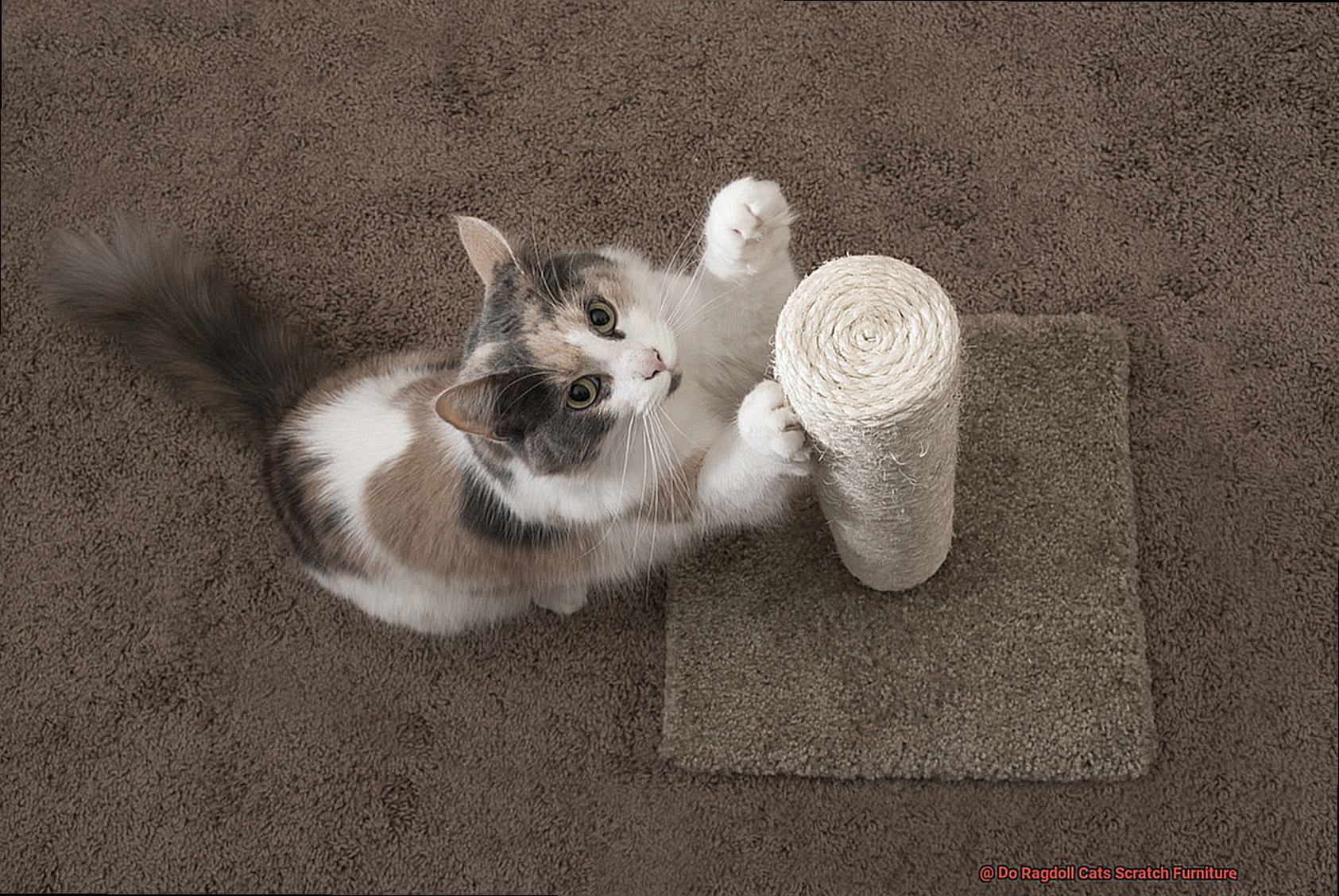Thinking about bringing a Ragdoll cat into your home? Wondering if they’ll scratch up your furniture? Well, as a feline expert, I’m here to tell you that it’s a bit of a yes and no situation.
Ragdoll cats are known for being gentle and docile, making them less likely to scratch up your furniture compared to other breeds. But let’s face it – every cat has an innate need to scratch, stretch, and sharpen their claws. If you don’t provide them with the right outlets, your couch might become their new favorite scratching post.
Don’t panic just yet. There are ways to prevent this from happening. By investing in a good scratching post or cat tree, you can give your furry friend the opportunity to scratch away without damaging your furniture. Plus, it’s a win-win situation – they get what they need, and you get to keep your couch intact.
So if you’re concerned about keeping your Ragdoll cat from scratching up your furniture, make sure to provide them with plenty of scratching options. Trust me – they’ll thank you for it. And who knows? You might even find that watching them play on their new scratching post is just as entertaining as binge-watching Netflix.
Stay tuned for more tips on how to keep your Ragdoll cat happy and healthy – without sacrificing the integrity of your furniture.
Do Ragdoll Cats Scratch Furniture?

But with all cats, comes the occasional urge to scratch and mark their territory. So, do Ragdoll cats scratch furniture? Yes, they do. However, there are ways to train your feline friend to scratch in appropriate areas.
One effective way to prevent your Ragdoll from damaging your furniture is to provide them with a designated scratching area. Choose a sturdy scratching post or pad that is tall enough for your cat to fully extend their claws and stretch out. Place it in an area where your cat spends a lot of time, such as near their bed or in a favorite lounging spot.
Unfortunately, even with a designated scratching area, some cats may still be drawn to your furniture. In these instances, deterrents can be a lifesaver. Double-sided tape or aluminum foil are both materials that cats find uncomfortable to scratch on. This can help train your Ragdoll to use their designated scratching area instead of your furniture.
Keeping your Ragdoll’s nails trimmed regularly is another important factor in managing their scratching behavior. Not only will it prevent damage to your furniture, but it will also promote your cat’s overall health and comfort. If you’re unsure how to trim your cat’s nails yourself, consult with your veterinarian or a professional groomer.
In addition to providing appropriate scratching surfaces and keeping nails trimmed, plenty of toys and playtime can help reduce destructive scratching behavior. Cats tend to scratch when they are bored or understimulated, so keeping them active and engaged can help prevent this from happening.
Reasons Why Ragdolls Scratch Furniture
Ragdoll cats are known for their gentle and loving nature, but they also have a tendency to scratch furniture. As a responsible pet owner, it’s important to understand why your Ragdoll scratches and how to redirect this behavior.
Natural Instinct
One of the primary reasons why Ragdoll cats scratch furniture is because it’s a natural instinct for them. Scratching is a way for cats to mark their territory, keep their claws sharp, and stretch their muscles. It’s important to provide your Ragdoll with appropriate scratching surfaces such as posts or pads. By redirecting their scratching behavior to these surfaces, you can preserve your furniture and satisfy their natural instincts.
Boredom or Stress
Another reason why Ragdolls scratch furniture is because they may be bored or stressed. Cats need mental and physical stimulation to remain happy and healthy. If they don’t have enough toys or playtime, they may turn to scratching as a way to alleviate their boredom. Additionally, changes in the household such as the arrival of a new pet or family member can cause stress in your Ragdoll which may lead to increased scratching behavior. In such cases, providing plenty of toys and playtime can help keep your cat active and satisfied, reducing the likelihood of destructive scratching behavior.
Communication
Finally, some Ragdolls may scratch furniture as a form of communication. Cats are very expressive animals, and scratching may be a way for them to communicate their needs or desires. For example, if your Ragdoll wants attention or food, they may scratch near you or the food bowl to get your attention.
It’s essential to understand that Ragdoll cats are not purposely trying to damage your furniture. They’re merely behaving according to their instincts and needs. As a responsible cat owner, it’s your duty to provide your furry friend with the necessary tools and resources to satisfy their scratching needs. This includes investing in sturdy scratching posts and pads that are tall enough for them to stretch out and scratch to their heart’s content.
How to Redirect Your Cat’s Scratching Behavior
Redirecting your Ragdoll cat’s scratching behavior is essential to protect your furniture and keep your feline friend happy. The first step in redirecting your cat’s scratching behavior is to provide them with a scratching post or pad. Cats love to scratch, and by providing them with an approved scratching area, you can train them to use it instead of your furniture.
When choosing a scratching post or pad, make sure it is tall enough for your cat to stretch fully and sturdy enough so it won’t tip over. Many cats prefer a vertical scratching post, while others prefer a horizontal scratching pad. Experiment with different types until you find one that your cat likes.
Once you have provided your cat with an approved scratching area, encourage them to use it by placing it in a prominent location and rubbing some catnip on it. You can also gently guide their paws onto the post or pad while praising them for using it.
If your cat continues to scratch your furniture despite having an approved area, try using double-sided tape or aluminum foil on the areas they like to scratch. Cats do not like the sticky feeling of the tape or the sound of foil, and this may deter them from scratching in that area.
It is also important to keep your cat’s nails trimmed regularly. This will not only help prevent damage to your furniture but also keep your cat healthy and comfortable.
Choosing a Suitable Scratching Post or Pad
Don’t fret, because there’s a simple solution – a suitable scratching post or pad.
When it comes to choosing the perfect scratching post or pad, there are a few important factors to consider. For starters, the material should be strong and durable enough to withstand your cat’s sharp claws. Popular options include sisal and cardboard, which many cats find enjoyable to scratch on.
In addition to the material, the height of the scratching post or pad is crucial for your cat’s physical wellbeing. It should be tall enough for them to fully stretch out when they scratch, helping them exercise and maintain their claws. After all, a healthy cat is a happy cat.
Location is also key. The scratching post or pad should be placed in an area where your cat spends a lot of time, such as near their bed or favorite spot in the house. This encourages them to use it regularly and helps redirect their scratching behavior away from your furniture.
But why stop at just one? Providing your Ragdoll cat with multiple scratching options throughout the house is highly recommended. This can include different materials, textures, and locations – giving them plenty of variety and reducing the likelihood of them getting bored with just one.
Using Deterrents to Discourage Furniture Scratching
Look no further. Deterrents are a popular and effective option for discouraging furniture scratching in cats.
One of the most commonly used deterrents is a spray that contains a bitter taste or smell, making the surface unappealing to cats. Simply apply the spray on furniture and other surfaces that your cat likes to scratch, and watch as they quickly lose interest. However, it’s important to note that some cats may still try to scratch even with the spray applied, so providing them with an alternative scratching surface is essential.
Scratching posts and pads are great alternatives that provide designated areas for your cat to scratch and claw. When selecting a scratching post or pad, make sure it’s made of materials that resemble those of the furniture pieces your cat tends to scratch. Place it near the furniture and encourage your cat to use it by rubbing some catnip on it or placing treats on top.
Another option is to cover furniture with materials like plastic or double-sided tape. Cats tend to avoid surfaces that feel sticky or uncomfortable on their paws, making this a great deterrent method.
While deterrents can be effective in preventing furniture scratching, addressing the underlying reason why your cat is scratching is crucial. Scratching is a natural behavior for cats and can serve as a way for them to mark their territory or relieve stress. Providing plenty of toys, playtime, and attention can help reduce their need to scratch furniture. Additionally, keeping their nails trimmed can minimize damage to furniture surfaces.
Providing Toys and Playtime for Your Cat
But there’s a simple solution to keep your furry feline friend entertained and prevent any further damage: providing toys and playtime.
Toys are an excellent way to provide your Ragdoll with an outlet for their natural scratching instincts while keeping them mentally stimulated and physically active. Interactive toys that require your cat to play actively are the most effective as they engage their hunting instincts. Here are some toy ideas to get you started:
Wand Toys – These toys mimic prey movements and encourage your Ragdoll to jump, pounce, and chase. Plus, they’re particularly popular with cats.
Puzzle Toys – These toys can dispense treats or require your cat to solve a problem, keeping them engaged and providing a mental challenge.
Balls – Cats love playing with balls. They can play with them solo or interactively with their human companions.
In addition to providing toys, it’s essential to set aside time each day for playtime with your Ragdoll. Regular playtime sessions not only prevent furniture scratching but also strengthen the bond between you and your furry friend. Aim for at least two 15-minute play sessions per day.
It’s important to note that not all scratching behavior is destructive or negative. Scratching is a natural and necessary behavior for cats, both for physical exercise and mental stimulation. Providing appropriate scratching surfaces such as scratching posts or pads can help redirect your Ragdoll’s scratching behavior away from furniture and onto a more suitable surface.
Keeping Your Cat’s Nails Trimmed Regularly
While it’s great for their physical and mental well-being, it can also cause damage to your furniture, carpets, curtains, and even walls. This is why keeping your cat’s nails trimmed regularly is crucial for both you and your furry friend.
Let’s dive deeper into the reasons why trimming your Ragdoll cat’s nails is an essential part of cat care:
Protect Your Belongings
Long nails can cause significant damage to your furniture and belongings. By keeping them trimmed, you can prevent scratches and save yourself some money in the long run.
Prevent Injuries
Long nails can also cause injuries to you or other pets in your home. If your cat accidentally scratches during playtime, it could lead to infection and require medical attention.
Maintain Your Cat’s Health
Trimming your cat’s nails is not only about protecting your belongings but also about maintaining their health. Long nails can curl into their paw pads and cause pain or infection, affecting their ability to walk properly.
Now that we understand the importance of trimming our cat’s nails let’s discuss how to do it:
Provide a Suitable Scratching Post
Start by providing a suitable scratching post or pad for your cat. Ragdoll cats prefer tall scratching posts that allow them to stretch fully when scratching. Place the post in an accessible area and encourage your cat to use it by rubbing it with catnip or placing toys on it.
Get Them Comfortable with Paw Touching
Before attempting to trim your cat’s nails, get them comfortable with having their paws touched and gently massaged. This will make the process much easier and less stressful for both of you.
Use the Right Tools
When trimming your cat’s nails, use a good quality pair of pet nail clippers. These will make the process smoother and reduce the risk of injury.
Avoid Cutting the Quick
When trimming your cat’s nails, be sure to avoid cutting the quick. This is the pink part of the nail that contains blood vessels and nerves. Only trim the white part of the nail and stop if you see any sign of bleeding.
If you’re unsure about how to trim your cat’s nails or don’t feel comfortable doing it yourself, seek help from a professional groomer or veterinarian.
Soft Paws and Nail Caps as a Protective Barrier
Soft Paws are small plastic caps that fit over your cat’s claws. Similarly, nail caps are made of rubber or silicone. These products act as a barrier, preventing damage to furniture, floors, and other household items.
The benefits of using Soft Paws and nail caps are plentiful. Firstly, they prevent costly repairs and replacements caused by scratching. Secondly, they’re easy to use and can be applied at home with minimal effort. Finally, these products are safe for cats when applied correctly; they don’t interfere with their ability to walk, jump, or scratch appropriately.
However, like any product, there are downsides too. Soft Paws and nail caps require maintenance; they need to be replaced every 4-6 weeks as the cat’s claws grow out. Additionally, not all cats will tolerate having their claws covered by Soft Paws or nail caps. Some may try to chew or scratch them off which can be frustrating for both the cat and owner. Lastly, if the caps are not applied correctly, they can cause discomfort or even injury to your cat.
Conclusion
In conclusion, it’s no secret that Ragdoll cats have a tendency to scratch furniture. But fear not. As a responsible pet owner, there are steps you can take to prevent this behavior from turning your living room into a shredded mess.
First and foremost, it’s important to understand why your cat may be scratching. Is it because they’re bored? Stressed? Or simply satisfying their natural instincts? Once you’ve identified the cause, you can redirect their behavior by providing appropriate scratching surfaces such as posts or pads.
But that’s not all. Keeping your cat’s nails trimmed regularly and providing plenty of toys and playtime can also help reduce destructive scratching behavior. And if all else fails, deterrents such as sprays or covering furniture with materials like double-sided tape can discourage your feline friend from using your couch as a scratching post.
But let’s not forget about Soft Paws and nail caps – protective barriers that act as armor against damage caused by scratching. With these options at your disposal, there’s no need to sacrifice style for the sake of a happy cat.
At the end of the day, remember that scratching is a natural behavior for cats – they’re not purposely trying to ruin your decor. By providing them with the necessary tools and resources to satisfy their needs, you can keep both your furry friend and furniture happy.


